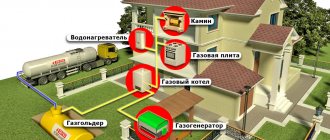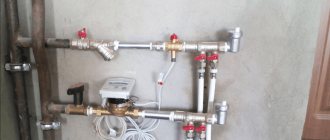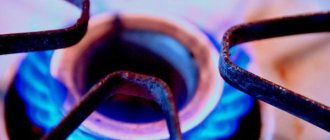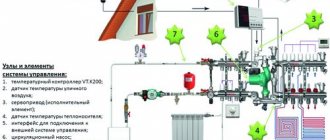Due to the high tariffs for the services of gas supply organizations, economical gas consumption is a sore point for most families living in a house with gas heating. The amounts on gas bills, especially in winter, can be simply unrealistic, right? Have you thought about how to save gas in a private home without sacrificing a comfortable microclimate?
We will try to help you solve this issue - in this material we will tell you about real ways to save money, tested by many consumers in practice. We will also consider alternative heat sources that can complement or completely replace gas in a private home.
What affects fuel consumption?
Combined gas stove. Photo by OZON
Gas is used for cooking, heating and water heating for general use. To figure out how you can save gas, you need to understand where it goes.
When heating, gas is used to heat the room. The more problems there are in the room, the more gas is consumed. Problems should include shortcomings ranging from an uninsulated attic and walls to cracks in window frames. The warmer the room, the less gas will escape. An additional burden on this part of the costs can also come from heated floors connected to the main heating.
Analysis of heat losses and ways to reduce them
In a private house, the greatest amount of heat is lost through windows, walls and roof. In addition, a certain amount of thermal energy is lost with the escaping air through the ventilation system, because warm air is replaced by cold outside air. Therefore, the following ways to save on heating are:
Firstly, insulating the roof or attic - using stone wool, foamed polymers, covering the roof with sandwich panels. In each specific case, the choice is made based on the characteristics of building structures and the solvency of the owner.
Secondly, reducing heat loss through windows. There are two acceptable methods here. The first is to reduce the total window area of the entire house, but at the same time reducing the amount of sunlight entering the premises. The second way is to install windows with better energy performance. These are windows with double and triple glazing, multi-circuit window systems and special windows, the glass of which is coated on one side with a thin layer that reflects infrared radiation.
Thirdly, insulating the walls of the house or constructing them from materials with better thermal characteristics.
Basic saving measures
Cooking food:
- Use the stove only after all products have been prepared for heat treatment. When cooking is finished, the burners must be turned off immediately.
- Use tight-fitting lids during cooking.
- Before cooking, boil water in a kettle and pour the hot water into the pan.
- Make sure that the flame does not leave the container. You can make it a rule to use appropriately sized utensils and burners.
- Use overhead “pancakes”. They evenly distribute heat over the bottom surface and enhance the heating effect of fire.
- If the stove is old, it is better to replace it with a more modern one.
- Use the gas stove only for cooking.
Fan heater. Photo by OZON
Heating a private house:
- Insulation of the room: walls, floor, attic, entrance doors.
- Installation of double-glazed windows that will maintain airtightness. Also, do not forget about the cracks that need to be sealed.
- Install an independent separate boiler for water heating.
- Place heat-reflecting foil elements between the heating radiator and the wall.
- It is better to replace old and less efficient batteries with optimized modern ones.
- Installing an automated temperature control system will help maintain a comfortable temperature in the right rooms at the right time without overheating empty rooms.
- Inspect and, if necessary, clean the heating system at least once.
- A ventilation device that will leave warm air in the room. A hood with a recuperator can also handle this.
Setting the boiler temperature
When setting the temperature of both water and heating, it is important not to go to extremes. You should not use maximum or minimum values. For hot water, a temperature of 38-39⁰ is suitable.
There is no point in setting the temperature higher and then mixing with the cold one, since the boiler warms up the full flow more efficiently than the half flow, which is then regulated by the mixer.
If you use a thermostat, it is best to set it in the coldest room, setting the temperature so that the house is comfortable.
It is important that it is not affected by nearby heating devices and direct sunlight.
This miracle can come complete with a boiler.
No matter what anyone says, warm floors are power. If we compare the heat transfer area of the radiator and the floor, the advantage is by no means in favor of the former. And the radiator cools down much faster than a block of concrete.
Having installed heated floors in all the rooms in my house except the bedrooms, I was as pleased as a cat. And what a thrill it is to go into the bathroom in the morning and step on the tiles as warm as a rug...
Fuel saving devices
There are several options for appliances: Gas Saver, thermostats and condensing boilers.
Gas Saver
It is better to purchase Gas Saver immediately with the purchase of a thermostat. It is a device based on a magnet. It is installed at the base of the pipe where the hose is screwed on.
The principle of operation is that gas molecules passing through the pipe are broken up under the influence of a magnetic field into an ordered structure. In this form, gas is consumed most efficiently.
The device helps save up to 30% fuel.
In addition, the advantages of Gas Saver include:
- no need to monitor the operation of the device;
- its small size will not spoil the interior; in extreme cases, it can be easily decorated;
- installation does not require special skills or experience;
- It's inexpensive.
Among the disadvantages are:
- inability to customize the device to suit your needs;
- the correctness of the installation and the results of the work will be noticeable only by the figures in the utility bills.
Important!
Homemade magnetic devices can damage gas meters.
Thermostats
Thermostat. Photo by OZON
A thermostat is a programmable gas saving device. Its task is to turn off and turn on the boiler when a threshold temperature value is reached. That is, as soon as the air in the room cools down to the user-programmed value, the thermostat turns on the boiler. On the contrary, when the room temperature becomes higher than the specified one, the device turns off the boiler.
Helps save up to 20% of consumed heat. The advantages also include:
- maintaining a comfortable temperature without constant monitoring of the boiler;
- quick payback for the device - in two months the device will recoup its price;
- eliminates the disorder of the boiler's on-off cycles, thereby extending its service life;
- There are different types of thermostats for specific needs and capabilities.
Attention!
If the room doesn't retain heat well, a thermostat won't be very effective. It works well only in combination with other gas saving measures.
The disadvantages of a thermostat include:
- the device requires careful handling, since its sensors can easily be damaged;
- each room requires its own thermostat, and the doors between these rooms must be closed so that the temperature does not equalize;
- requires the correct installation location.
Condensing boilers
A condensing boiler is a more advanced gas boiler with two chambers. It uses the energy of condensation formation during fuel combustion. The principle of its operation is quite simple: exhaust gases are sent from the first chamber to the second, where they begin to heat the cooled combustion products. In this case, condensation forms, which is collected in a special tank.
Savings when using a condensing boiler will be 30 - 35%. This type of boiler has other advantages:
- more environmentally friendly than conventional boilers;
- noise and vibration levels are also lower;
- part of the heat exchanger is itself cleaned with condensate, and the design of the boiler itself minimizes its need for cleaning;
- the total weight of the equipment is lower.
The only drawback of such a boiler is its cost, which will not pay off as quickly as a thermostat.
Ways to save at home
There are several options for saving: from selecting a heating system to upgrading a gas boiler.
Selection of heating system
Radiator controller. Photo by AliExpress
To select a heating system, you must go through 6 steps:
- Calculation and measurement of heat loss at home. To do this, you can use various online calculators that will ask for the area of the walls, the thickness and type of its layers, and the type of facade. If you divide the result by the square footage of the room, there will be heat loss in W per m². On average they are in the region of 50 - 150 units.
- Selecting temperature mode. This can be European mode, low temperature and others. Imported ones are set to 75° at the water outlet from the boiler, 65° at the inlet and 20° room temperature.
- Calculation of radiator power. Based on the results of the first step and the second step, and the data of the selected manufacturer, radiators are selected to suit your characteristics and needs.
- Calculation of pipe diameters and characteristics of the circulation pump.
- Boiler selection.
- Calculation of system volume. Online calculators will help with this. If the previous steps have been completed, it will not be difficult to calculate the need for additional capacity for the boiler.
Attention!
It is important to take into account warm water floors in the calculation.
Insulation of the gas meter
The method is based on the laws of physics and a meter installed on the street, but is not effective. The lower the temperature of the incoming gas, the higher its density.
Nowadays, thermal correctors are installed in meters that take this feature into account and give readings in accordance with them. If the meter is installed without a thermal corrector, then the management company itself carries out the recalculation. Insulating the meter does not provide a noticeable increase in benefits.
Gas boiler modification
Digital thermostat. Photo by AliExpress
Modification of a gas boiler will increase its efficiency. There are several methods:
- Installation of a turbulator - plates that increase the area of heat energy extraction.
- Find the most optimal position of the blower damper. This will ensure maximum combustion of gas in the chamber.
- Keeping the boiler clean. This applies to all its parts.
- Reducing heat loss from the boiler itself. This is the use of a wall-mounted boiler instead of a floor-standing one, the correct selection of heating equipment.
Setting up automation Eurosit 630
Configuration is carried out after mounting the system. Adjustment is carried out using a knob. It switches the boiler to 3 positions: switching on, ignition and temperature mode.
To turn on the automation, the knob must be turned to the ignition position. When pressed, the piezoelectric element will be activated, which will ignite the pilot burner. You should hold this position for ten seconds to half a minute. After releasing the button, the igniter should stop working.
For more information about this automation, see the article Gas automation Eurosit 630.
Warm floor
Depending on the type of flooring, you will have to choose between water, infrared and electric flooring. The last two can be turned on instead of the main one, instead of the main heating, when it’s just cool outside.
Reference
A water floor will allow waste water from the boiler to be used more efficiently.
How to save gas when heating your home, additional methods
However, no matter what modern heating system you install, people will always use it. Therefore, other things being equal, gas consumption among different owners differs quite significantly. There are many related tricks that will help you achieve the desired savings:
- Insulation of the external walls of the house, attic and basement.
- Installing new energy-efficient windows and doors or carefully sealing old ones.
- The use of energy-reflecting screens made of aluminum foil between the wall of the room and the heating radiator, which allows you to return some of the heat back into the room.
- Carrying out thermal insulation of cold bridges.
- Curtains should not cover working radiators, this steals heat.
- Insulation of the boiler and boiler, as well as pipes extending from them, if the equipment is located in an unheated room.
- The heat exchanger of a gas boiler should be cleaned at least once a year. The dirt and dust that accumulates there causes the unit to consume more energy.
- The burner in a non-working gas column should not be in an active state. The asking price is 1 cubic meter of gas per day.
If at least some of these tips are put into practice, then the owner of a private house can count on savings of 20-30%.











